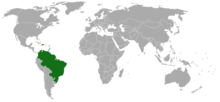This article has multiple issues. Please help improve it or discuss these issues on the talk page. (Learn how and when to remove these messages)
|
| Anadenanthera peregrina | |
|---|---|

| |
| Scientific classification | |
| Kingdom: | Plantae |
| Clade: | Tracheophytes |
| Clade: | Angiosperms |
| Clade: | Eudicots |
| Clade: | Rosids |
| Order: | Fabales |
| Family: | Fabaceae |
| Subfamily: | Caesalpinioideae |
| Clade: | Mimosoid clade |
| Genus: | Anadenanthera |
| Species: | A. peregrina
|
| Binomial name | |
| Anadenanthera peregrina | |

| |
| Range of Anadenanthera peregrina | |
| Synonyms | |
|
Acacia angustiloba DC. | |
Anadenanthera peregrina, also known as yopo, jopo, cohoba, parica or calcium tree, is a perennial tree of the genus Anadenanthera native to the Caribbean and South America.[2] It grows up to 20 m (66 ft) tall, and has a thorny bark. Its flowers grow in small, pale yellow to white spherical clusters resembling Acacia (e.g. wattle) inflorescences. It is an entheogen which has been used in healing ceremonies and rituals for thousands of years in northern South America and the Caribbean.[3] Although the seeds of the yopo tree were originally gathered from the wild, increased competition between tribes over access to the seeds led to it being intentionally cultivated and transported elsewhere, expanding the plant's distribution through introduction to areas beyond its native range.[4]
- ^ Botanic Gardens Conservation International (BGCI).; IUCN SSC Global Tree Specialist Group (2019). "Anadenanthera peregrina". IUCN Red List of Threatened Species. 2019: e.T144262459A149021134. doi:10.2305/IUCN.UK.2019-2.RLTS.T144262459A149021134.en. Retrieved 18 November 2021.
- ^ a b "Anadenanthera peregrina - ILDIS LegumeWeb". www.ildis.org. Retrieved 2008-05-17.
- ^ Carod-Artal, F. J.; Vázquez Cabrera, C. B. (July 2007). "[Ritual use of Anadenanthera seeds among South America natives]". Neurologia (Barcelona, Spain). 22 (6): 410–415. ISSN 0213-4853. PMID 17610173.
- ^ "Anadenanthera peregrina - Useful Tropical Plants". tropical.theferns.info. Retrieved 2022-08-26.
